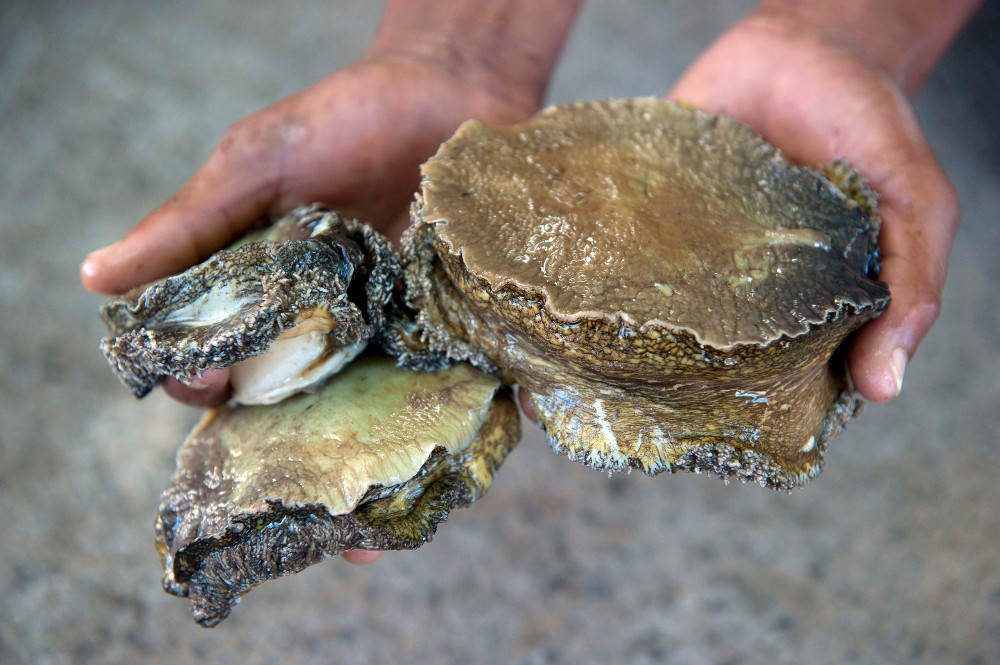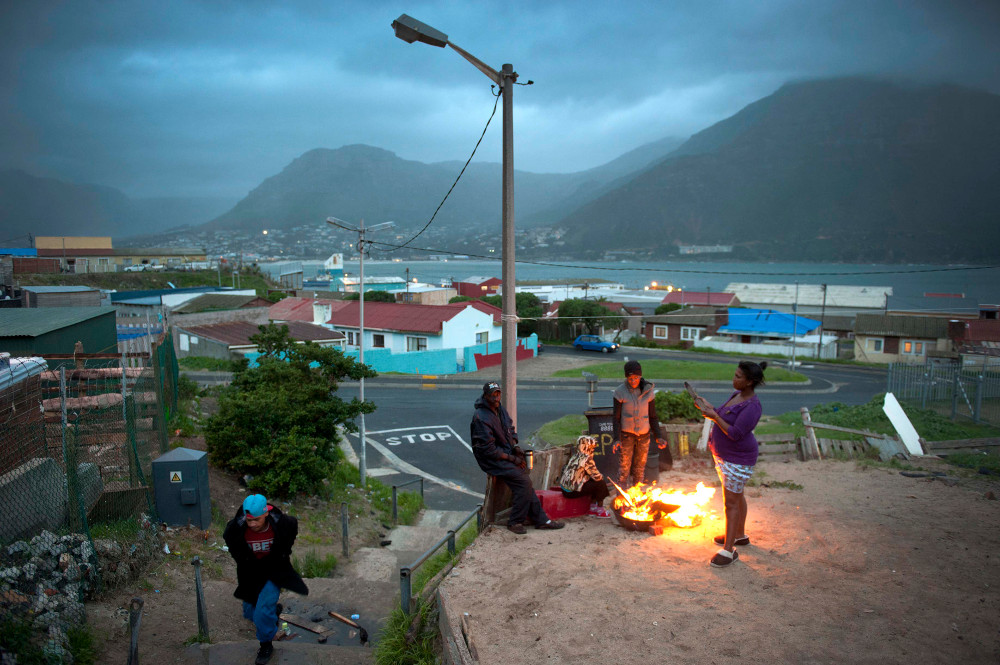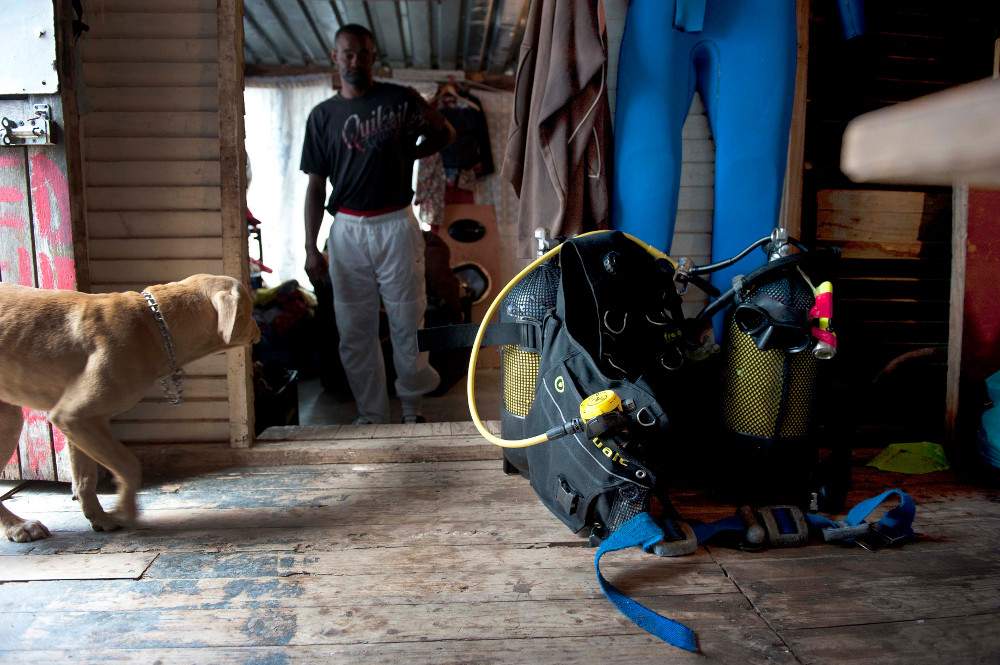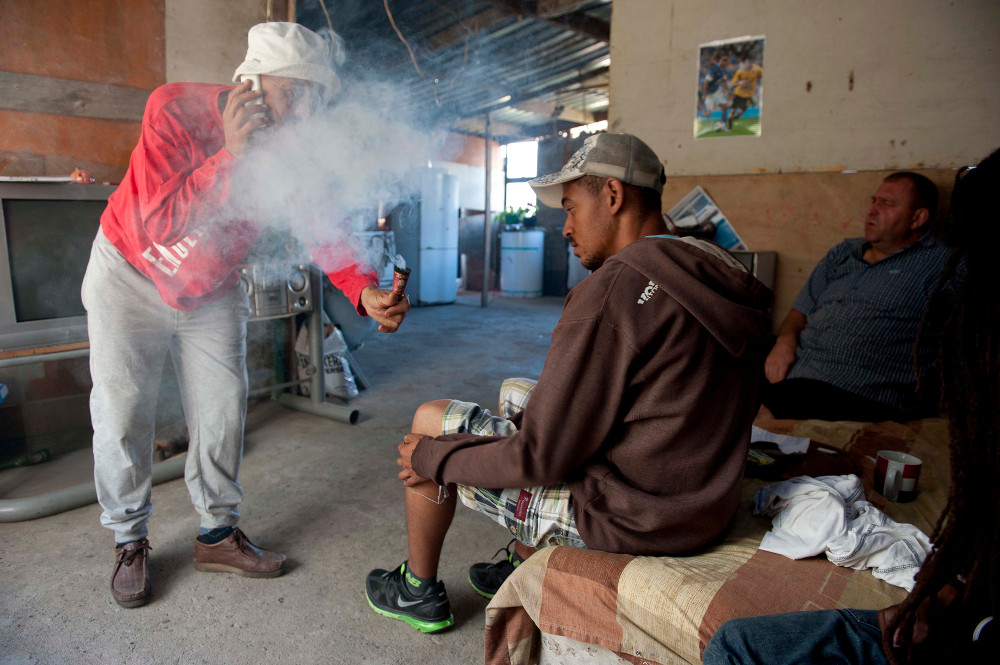Abalone poaching forms a major part of the informal economy in Hout Bay's Hangberg community.
A little over a year ago, I drove my scooter into Hangberg in the Western Cape and met a perlemoen poaching kingpin. It was a Wednesday afternoon and the sun was out. Six shirtless men were sitting on camping stools and upturned crates on the pavement.
My contact, David*, who lived in the adjacent apartment, was nowhere to be seen and I could feel the men’s eyes following me as I parked. The clip on my helmet jammed; I fumbled and tugged myself free. I crossed the road and greeted them to little response, then walked into the empty yard.
David met me at the front door with a mug in his hand. He had shaved since the first time we met and was wearing a red tracksuit, looking fresh despite his greying hair and furrowed cheeks. Loud music thumped from the lounge. An ancient washing machine had been carried outside and was shuddering on the dirt beside us. A young boy brought chairs and David handed him a folded banknote, and the kid ran off while the two of us sat in the shade of a low tree, smoking cigarettes.
The men on the other side of the fence shared a hookah pipe and watched the street. They argued in rapid-fire Afrikaans, whistled at girls, threw dice, taunted the occupants of a passing police van and roundly ignored my presence.
I’d met David through a fisheries researcher who had investigated crayfish poaching in Hangberg for her doctorate. The two had worked together – David once participated in an illicit rowboat-based kreef (crayfish) harvesting operation – and she assured me he’d become “heavily involved” in the perlemoen trade as well. She gave me his number and I called him immediately.
Clandestine economy
By then I’d already spent a month sniffing at the edges of Hout Bay’s clandestine poaching economy, lurking around the harbour at night, watching unmarked rubber ducks launch and approaching stoned watchmen and prostitutes for leads. I had managed to interview a diver, a former middleman and a small group of carriers. But I needed deeper access to get to grips with the socioeconomic drivers and impacts of perlemoen poaching in the community, the main objective of my research, and time was running out.
The boy who’d brought the chairs returned with a newspaper parcel of marijuana, which David lobbed to an older kid leaning against the fence. ” Maak ‘n pyp [make a pipe],” he instructed, and the kid sat and winnowed seeds for a smoke.
I asked David about a large rubber duck I’d seen launching from the harbour as I drove in. Most perlemoen poaching in South Africa takes place from high-speed boats now, and part of my research entailed finding out how many were active in Hangberg.
“It was bigger than the others I’ve seen around here,” I explained.
“You mean like a white man’s boat?”
Working clever
One of the shirtless men from next door spun around. His eyes were wide and his chin was thrust forward aggressively. He had broad shoulders, thick biceps and a round belly. Tattoos sprawled across his hands and up his forearms.
“I mean like a very nice boat.”
“We don’t fuck with nice boats. You can’t put down that kind of money when you know the cops might catch you – then you lose half a million rand. You must work clever, man.”
He turned away but the others were watching.
“So you know Denver*?” David asked.
“No.” He laughed and lifted the pipe. “Denver’s a big man around here. If you don’t know Denver, you know nothing.”
Conservation angle
I was attempting to profile illegal perlemoen harvesting in Hout Bay as part of a master’s in conservation biology at the University of Cape Town. Working beneath academics from the Environmental Evaluation Unit, an interdisciplinary research group with a strong focus on fisheries governance, I was interested in getting an inside view of one of the most pressing conservation and natural resource management threats in this country.
Since the late 1980s, rampant poaching has decimated perlemoen stocks throughout the Western and Eastern Cape, driving the species, which is endemic to South Africa and found nowhere else on earth, to the brink of commercial extinction. Perlemoen, a giant kelp-grazing sea snail commonly known as abalone, is considered a delicacy and a status symbol in the Far East, where its flesh fetches prices of up to thousands of dollars a kilogram.

Abalone, or perlemoen. (Photos: David Harrison, M&G)
A commercial abalone fishery, based mainly on the Overberg coast, has supplied wealthy consumers in places such as Japan, China and Hong Kong since the end of World War II, but sharply rising demand, coupled with the infiltration of organised criminal groups into impoverished fishing communities, has contributed to a spiralling nightmare of uncontrolled harvesting over the past two decades.
According to estimates by Marcus Burgener from Traffic, the international wildlife trade monitoring group, between 1 500 and 2 200 tonnes of perlemoen have been poached annually between 2009 and 2012. This is more than 10 times the total allowable catch, a figure set annually by scientists at the department of fisheries.
The commercial fishery still operates but has shrunk to a fraction of its former size, with officials unable to justify larger quotas in the face of accelerating resource depletion. Meanwhile, a sophisticated criminal economy, involving transnational Triad groups, local street gangs and other powerful underworld players, continues to pump vast cash sums into procuring illicit products for the Asian market, where purchasing abalone over the counter is still permitted.
Some of this money ends up in places like Hangberg, a predominantly coloured fishing community still battling the structural hangovers of apartheid. One of my goals was to understand the different roles this revenue stream had started to play.
‘Wit man’
The morning we first met, David waited for me on the corner and directed me to his home, a small two-bedroomed unit on the ground floor of a dilapidated row of council flats. A broken boat was parked on a trailer opposite. A Rastafarian with giant, calloused hands stared me down as he mulled a fistful of marijuana at the gate.
” Wit man, wat maak jy hier? [White man, what are you doing here?]” the Rasta asked as we entered, not waiting for a response.
“Look,” said David, reaching behind a potted mint bush and handing me a perlemoen shell the size of his face. It was an immense, humped, deep thing, rutted and grey on the outside, pearlescent and smooth within. “This is a trophy,” he said. “From a reef near Cape Point. It’s the biggest they get.”
He explained his poaching work as we sat amid the plants and the Rasta, whose name was John*, continued preparing his spliff. David told me he skippered a boat for a white diver who had relocated to Hout Bay to target reefs on the Cape Peninsula. Another local diver – whom by chance I’d already interviewed – worked with them, as well as a bootsman, or deck assistant.
The divers paid David R20 a kilogram of perlemoen they harvested; the bootsman earned half as much. The divers also hired carriers to run their catch to middlemen in the community, who paid prices of between R200 and R250 a kilogram. These middlemen sold the product on to buyers from larger criminal syndicates, who ultimately controlled the illicit trade to the Far East.
On a good night, after expenses, the two divers could earn R10 000 each, with David taking home R4 000.
Poaching hierarchy
As a skipper, David occupied an intermediate position in the poaching hierarchy, which extended from powerful buyers and middlemen (local kingpins) down to part-time carriers, many of whom were still in school. Compared with the men at the top – men like Denver – David was not a wealthy man: his apartment was simply furnished, his clothes were worn and he owned no vehicle. Nevertheless, he managed to put food on the table for his wife and four children, pay school fees and buy his sons soccer boots.
He could also afford high-grade marijuana, so-called “cheese” that sold for R100 a gram, which he mixed in with the cheaper majat that people grew on the slopes behind the settlement.

Small-scale fishers have been routinely excluded from local fishing quotas, leaving them no legal way of accessing the marine resources they depend on for survival.
“You want some?” John interrupted. He had struck a match and was holding the joint towards me. I hesitated. A researcher is supposed to maintain clear boundaries in the field: no drinking, no drugs, no buddy-buddy behaviour. Yet here, finding things out was contingent on being accepted by an unfamiliar and guarded group of people, and smoking together seemed a good way to build trust.
“Not while I work,” I said. “I’ll forget everything.”
The standard narrative about poaching in South Africa, particularly within the mainstream environmentalist discourse I’m familiar with, is predominantly one of outrage and condemnation.
My research took a different approach.
Verge of extinction
Perlemoen poaching is unquestionably bad: it has pushed stocks to the verge of extinction and contributed to the rise of a range of social ills – gangsterism, turf wars, drug addiction and other undesirable by-products of the black market – in coastal towns throughout the Western and Eastern Cape.
By injecting unprecedented cash sums into places the formal economy has overlooked, poaching has allowed new power elites to develop, closely aligned with the criminal elements necessary to enter and navigate any illicit trade. This has restructured many fishing communities around broad themes of lawlessness, placing them in direct opposition to the state.
Yet taking a moral stance on the illegal perlemoen fishery, and failing to fully consider the circumstances that contributed to its evolution, often amounts to superficial engagement with a much deeper set of problems.
To illustrate, Hangberg was, and still is, a desperately poor area with few opportunities for meaningful employment. Fishing is the reason for the settlement’s existence and by far its most prevalent vocation. But in the past two decades processing factories in the harbour have closed down, commercial fishing companies have trimmed their crew requirements and African immigrants have begun to compete more strongly for jobs, making it difficult for locals to find work.
Meanwhile, post-apartheid fisheries reform has proceeded slowly, leaving many in the community without viable permits. Since 1994, South African fisheries officials have grappled with a difficult problem: how to transform the industry without impacting negatively on resources or economic stability.
Quota allocations
More pressingly, small-scale fishers – loosely defined as those who fish close to shore using inexpensive boats and equipment, but sell their catch – have been routinely excluded from quota allocations, leaving thousands with no legal way of accessing marine resources.
In places like Hangberg, where valuable species such as crayfish and perlemoen are readily accessible, many people have turned to poaching as an alternative, rejecting a formal system that continues to overlook their interests.

Boat owners allocate spots to a shifting crew of divers in exchange for “boat fees” of 10kg of fresh perlemoen each.
It was early evening and the quayside restaurant was filling up with families, middle-aged couples and businessmen. Overhead heaters glowed red to ward off the chill after a balmy, windless day. Hout Bay harbour was still, with catamarans bobbing alongside the marina and larger fishing vessels moored against the wharf.
Writing notes after another afternoon with David, I was preoccupied with something else: not 30m away, at the slipway, a trailer carrying a large rubber duck was reversing into the water, and I was trying to identify its occupants. Seven men clambered aboard and started tinkering. The cover of one outboard motor came off. Blue smoke spiralled into the air. I thought I could see Denver on the jetty, issuing instructions, and I grabbed my things and made for the exit.
A group I didn’t recognise turned as I approached the jetty, their body language hostile. I kept walking.
“No, this one’s my bra,” called Denver, whom I hadn’t noticed standing to one side. His eyes were bloodshot. We hadn’t spoken since our first encounter.
Boat owners
I’d subsequently passed him a few times in the street – like many of Hangberg’s most successful poachers, he drove an expensive car – and I’d tried phoning repeatedly, but he’d brushed me off each time.
By then I knew that he was one of a small group of boat owners in the community, allocating spots to a shifting crew of divers in exchange for “boat fees” of 10 kilograms of fresh perlemoen each (equivalent to roughly R2 000 a head). Up to 10 men could pack onto a single rubber duck. To my knowledge, Denver owned three.
This had elevated him to a position of great power and status in the local poaching hierarchy. Compared with David and almost everybody else in Hangberg, Denver was visibly flush, dressing in Caterpillar boots and cruising his sports car down the narrow roads of the settlement.
Within the context of an oppositional street culture he thus represented an example of somebody who had “made good”, toughing out the many obstacles poachers face – police scrutiny, dangerous working conditions, conflict with rival groups in a criminalised economy – to climb to the top of the pile.
Standing beside the slipway in the gathering dusk, I was just relieved he was being friendly.
Too calm
“How’s the research?” he asked, taking my hand.
“I wanted to see whose boat this was,” I explained. “I was having a drink at the Lookout.”
“It’s mine. We’re fixing it. The engine was broken.”
“Are you going out tonight?”
“No man, the sea is too calm. The police will be out. I’m gonna go home and smoke a pyp.”
“I’d still like to interview you properly,” I reminded him as he turned towards the vehicle. He paused.
“Are you sitting with a girl there inside?”
“Yes,” I lied.
“I want a nice white girlfriend,” he said. “You must help find me one. Now I must go.”
Black market
Despite my repeated attempts I never met with Denver again, but I wrote a dissertation. Ultimately, as an outsider, there were limits to how deeply I could penetrate the illicit economy. Through my contacts, which also included conservationists and law enforcement officials, I learned that perlemoen poaching had taken off in Hangberg in the early 2000s, surprisingly late considering that individuals on the Overberg coast, as well as a small group of divers on the Cape Peninsula, had already been supplying the lucrative abalone black market for over a decade.
Teams from established hot spots such as Gansbaai and Hawston had started operating out of Hout Bay, showing locals the ropes and helping to kick-start Hangberg’s own illegal perlemoen fishery. Around the same time, a few residents had connected up with outside buyers and became middlemen, establishing a crucial link between Hangberg’s new poachers and the broader abalone economy.

Divers use carriers to run their catch to middlemen who sell the product on to buyers from larger criminal syndicates, who ultimately control the illicit trade to the Far East.
Allegedly, some of these outside buyers also funded the purchase of boats and equipment, strategically investing in a new supplier for their booming Far Eastern markets.
Within five years local poachers were operating their own vessels in addition to diving from shore, mainly targeting Robben Island for its abundant stocks. The centre of South Africa’s illicit perlemoen trade was shifting westwards from its historical Overberg nexus as resources there depleted and anti-poaching efforts improved, leading to increased competition on the Cape Peninsula.
Inevitably, locals began asserting ownership of what they perceived as “their” stocks, barring outside groups from operating without permission and charging “taxes” for launching from Hout Bay harbour.
Snowball effect
Poaching snowballed from the mid-2000s onwards as growing numbers of residents – schoolboys, unemployed fishermen, mothers willing to refrigerate batches of contraband in their homes for a fee – saw the money on offer and decided to join in. More than 250 people in Hangberg received a direct income from the trade in 2012, I estimated, ranging from carriers hauling dripping sacks uphill for less than R500 a trip to divers and boat owners capable of earning 20 times that amount from a single operation. Indirectly, this meant that perhaps 1 000 people were dependent on the illegal fishery.
Poaching had started operating as a functional alternative to the state-run fisheries sector, servicing the needs of a community that had been overlooked for decades.
On the afternoon I first met Denver, he was sitting in his chair.
“Speak to this guy,” David urged him. “He’s doing this project and he doesn’t [know] what the fuck is going on.”
“What do you want to know?” Denver asked me, his eyes narrow.
Misunderstood
“I want to know how poaching works here, how it affects your lives,” I stumbled, unprepared. “I’m from the university. A lot of people there don’t understand poaching; they don’t know what it’s like for people living in places like this. I want to hear your side of the story.”
Denver spat on the ground.
“People on that side, people like you? They just sit and judge; they’re always judging.”
Somebody handed him the pipe and his face vanished in a cloud of mint-flavoured smoke. “They don’t know what’s really going on.”
*Not their real names.
The writer received a bursary from the University of Cape Town to prepare this article.